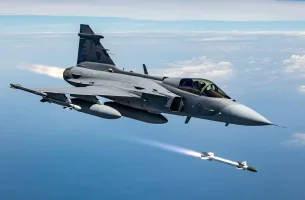- Views: 3K
- Replies: 19
Saab Aeronautics is actively promoting its Gripen-E fighter aircraft for the Indian Air Force’s (IAF) major procurement plan, known as the Multi-Role Fighter Aircraft (MRFA) tender, which seeks to acquire 114 advanced jets.
The Swedish aerospace company highlights the Gripen-E's distinct design features, particularly its capacity for rapid adaptation and seamless integration with weapons manufactured in India, such as the Astra series of air-to-air missiles.
A key official from Saab Aeronautics, Per-Olof Marklund, Director and Head of Technology and Innovation, pointed out the aircraft's highly flexible and open avionics system.
This design, described as a "split avionics architecture," is unique to the Gripen-E. It allows for the swift incorporation of new weapons and sensor systems, potentially reducing integration times significantly compared to traditional fighter jet designs.
This adaptability is presented as a major advantage for India, supporting the nation's push for self-reliance in defence production under the Aatmanirbhar Bharat initiative.
The split avionics system separates the aircraft's essential flight control systems from its mission-specific equipment, such as sensors and weapons. This modular approach, combined with standardized software interfaces within the Mission System Software (MSS), enables a "plug-and-play" capability.
According to Saab, this means new weapons, including India's own Astra Beyond Visual Range Air-to-Air Missiles (BVRAAM) – encompassing the existing Mk-1 (110 km range), the upcoming Mk-2 (160 km), and the future ramjet-powered Mk-3 (planned 350 km range) – can be integrated quickly without needing complex software overhauls.
Other potential integrations mentioned include the Rudram anti-radiation missile, Smart Anti-Airfield Weapon (SAAW), and the compact BrahMos-NG missile.
Beyond weapon flexibility, the Gripen-E is equipped with advanced sensors providing pilots with comprehensive situational awareness. These include the Leonardo Raven ES-05 Active Electronically Scanned Array (AESA) radar and the Skyward-G Infrared Search and Track (IRST) system, alongside a modern electronic warfare suite for defence against sophisticated threats, including stealth aircraft.
Saab also emphasizes the aircraft's operational reliability, citing a 93% mission-capable rate, which translates to a high number of available aircraft for missions, a crucial factor for the IAF given the regional security environment.
Supporting India's industrial ambitions, Saab's proposal includes a full 100% Transfer of Technology (ToT). This involves establishing local production facilities in India, reportedly in partnership with the Adani Group, and sharing critical source codes. This comprehensive offer aims to help India build a robust domestic aerospace manufacturing base.
Furthermore, the Gripen-E's design adheres to NATO standards, ensuring interoperability with other systems used by the IAF, like its Integrated Air Command and Control System (IACCS).
Saab states the architecture is built for future growth, ready to incorporate advancements like artificial intelligence (AI) for enhanced targeting and networked warfare capabilities, aligning with the IAF’s long-term operational plans towards 2035.
Saab positions the Gripen-E as a technologically advanced, adaptable, and strategically aligned option for India's future fighter fleet requirements.

